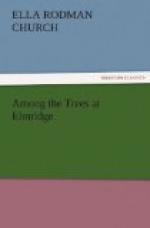“’Smooth
linden best obeys
The carver’s chisel—best
his curious work
Displays in nicest touches.’
“The fruits and flowers carved for the choir of St. Paul’s cathedral in London are done in lime-wood.
“So numerous are the purposes to which the bark, wood, leaves and blossoms of the lime, or linden, tree can be applied that centuries ago it was called the tree of a thousand uses. Linden is the name by which it is always known on the continent of Europe, and there it is indeed a magnificent tree, forming the most delightful avenues and branching colonnades. One of the principal streets in Berlin is called ’Unter den Linden.’ In the Middle Ages, when the Swiss and the Flemings were always struggling for liberty, it was their custom to plant a lime tree on the field of battle, and many of these old trees still remain and have been the subject of ballads and poetical effusions:
“‘The stately lime, smooth, gentle, straight and fair.’”
“Is there any story about it, Miss Harson?”
“No,” was the reply, “not much of a story; only descriptions of some very large and very ancient trees. One of these, the old linden tree of Soleure, in Switzerland, was spoken of by an English traveler two hundred years ago as ’right noble and wondrous to behold. A bower composed of its branches is capable of holding three hundred persons sitting at ease; it has also a fountain set about with many tables formed solely of the boughs, to which men ascend by steps; and all is kept so accurately and thick that the sun never looks into it.’”
“It is just like a tent,” said Malcolm, “it must be pleasant to sit by the fountain. Wouldn’t you like it, Miss Harson?”
“I am sure I should,” replied his governess; “and I should also like to see the famous lime tree of Zurich, the boughs of which will shelter five hundred persons. At Augsburg, in Germany, feasts and weddings have often been celebrated under the shade of some venerable limes that branch out to an immense distance. In early times divine honors were paid to them as emblems of immortality. And now,” said Miss Harson, “the last of these famous trees is a noble lime tree which grew on the farm belonging to the ancestors of Linnaeus, the great naturalist, beneath the shade of which he played in childhood, and from which his ancestors derived their surname. That noble tree still blossoms from year to year, beautiful in every change of seasons.”
“Lime, linden and basswood,” said Clara—“three names to remember for one tree. But didn’t you say, Miss Harson, that it’s always called basswood in our country?”
“Often, but not always. The name linden is quite common with us, and it will be well for you to remember that it is also called lime, so that when you go to Europe you will know what is meant by lime and linden.”
The children laughed at this idea, for it seemed very funny to think of a little girl like Clara going to Europe, but, as their governess told them, little girls did go constantly; besides, this was the time to learn what would be of use to them when they were grown.




